Suddenly, about this time of year, a special bird from the far north would appear on the water, and under the water, at a favorite coastal wetland just inland from the Pacific Ocean in southern California. Not the same bird, not even the same species, but definitely a loon. One year a Common Loon, another year a Red-necked Loon, and a couple years Pacific Loons – always spectacular birds! Most West Coast loons winter offshore from the Pacific Coast sand, at or near the surf zone, but also far offshore – always diving, sometimes diving deep, always in search of the next fish.
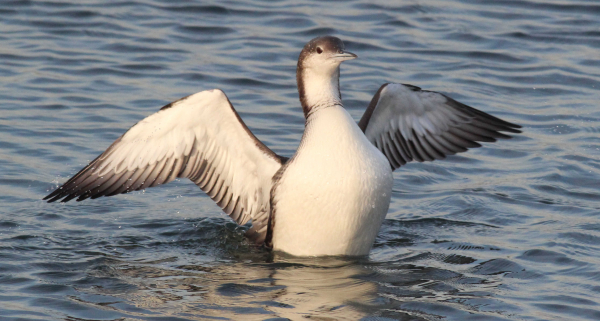
The offshore birds are tougher to access with any level of regularity, but when a loon stops in at Bolsa Chica Wetlands in Huntington Beach, it provides a focus point among the variety of birds that utilize the coastal waters. Luckily, the loon of the year always seems to center its activities near the Bolsa Chica boardwalk, which splits the western channel of the Wetlands and provides a great opportunity to photograph waterbirds, wading birds, ducks, terns, gulls, and skimmers that become familiar with the people walking by, some stopping with their binocular or camera. But when a loon is present, it’s time to focus – focus your attention and focus your camera lens on these elusive wintering waterbirds.
The first winter loon I had a chance to photograph was a first-winter Common Loon that came to Bolsa Chica the week before Thanksgiving, one of the most beautiful times of the year in southern California when the wind is often still and the sun low in the southern sky. You can’t ask for better lighting or prettier water than you get during those conditions, so all I needed to do was add a special bird to the frame, and that’s where the fun began.
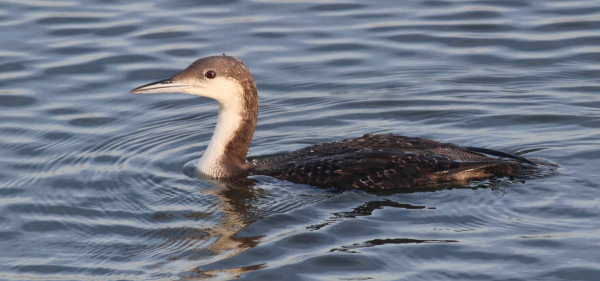
But it was a Pacific Loon that provided my best winter loon photos. Pacific Loons are much harder to find inland than Commons or Red-throated Loons, so I spent as much time as possible with this individual to try to get some action photos along with the usual species portraits. My hope was granted when the Pacific Loon did an occasional wing flap, raising up on the water to exercise its wings and reposition feathers into place after multiple dives. With an aperture setting of f-10 and associated shutter speeds of 1/1250 and 1/1600 using an ISO of 400, it all seemed to work out in the resulting photos – plenty of depth of field and a fast enough shutter speed to stop the considerable action of the beating wings.
By walking and standing on the boardwalk at Bolsa Chica, which passes just a few feet above the water, it’s possible shadow a bird hunting within lens range to the structure. In fact, at times the loon was chasing small fish schooled near the boardwalk, and I could see the action below the surface of the water as the loon swam quickly a foot or so below the surface while abruptly turning this way or that to try to catch a small fish as they split away from the schools.
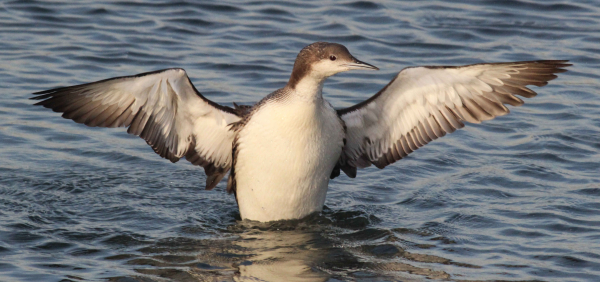
Beyond SoCal
Of course, there are plenty of other places where you might intercept wintering loons, although its often a matter of luck to find one that’s close enough to photograph as you travel. It helps if you can get on an offshore seabirding boat trip, or even a whale watching ship. I have been able to find winter loons at other coastal areas, most significantly for photography at Monterey Bay in northern California, and by chance, Port Lavaca, Texas. But winter loons can potentially be found anywhere along the Lower 48’s Atlantic, Pacific, and Gulf Coasts, and to a lesser extent along the shore of the Great Lakes, and rarer yet at large inland reservoirs or lakes.
The Monterey marina area offers a chance to search for wintering loons close to shore, and there are a couple different options of approaching loons on the water, by kayak or canoe, by taking a small glass-bottomed boat trip near shore, or heading into the bay and offshore by taking a seabirding or whale watching ship. During a memorable New Year’s trip to Monterey Bay I was able to take a favorite portrait of a winter Red-throated Loon, distinguished by its thinner, upturned bill among other features.
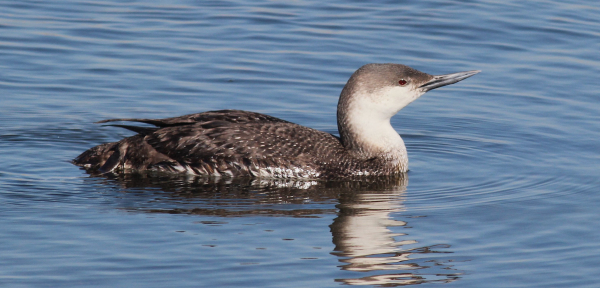
The Red-throated Loon was encountered at a quiet nook on one of the public wharfs on the bay side of Monterey, positioned in the best possible lighting and water conditions. I photographed this bird using ISO 200 at an aperture of f-10 that yielded a shutter speed of 1/640 of a second. This loon proved to be pretty inactive, which is true for most of the Red-throats I see in tranquil waters, although it dived on the hunt periodically.
My best look at a pair of adult Common Loons in basic winter plumage came by chance as I drove to Aransas National Wildlife Refuge along the Gulf Coast of Texas. Just as I began crossing the bridge across Lavaca Bay at Port Lavaca, I sighted the pair of loons. Without question I retraced my drive across the spanning bridge and relocated the loons, in spite of the heavily overcast drizzling weather that only produced a minimum of light. The elegant loons turned out to be easily accessed from the shore adjacent to some boat docks, and I was able to photograph the pair together and each bird separately – all in terrible light.
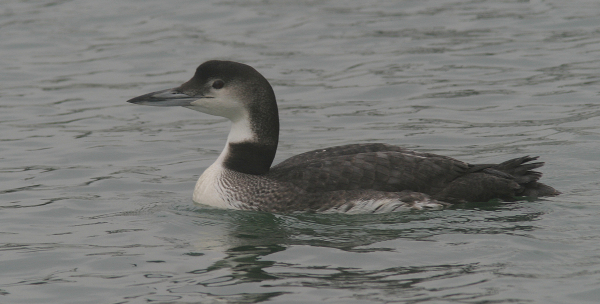
The Common Loons were colored in varied shades of gray with black and white areas of plumage, and the water was a dirty gray color, producing photos of the loons that absolutely looked like black-and-white photos. The exemplary portrait of the big male loon shows its strong head form and bill size well, but I hope to improve my winter photos of Common Loons another time, another place. I share it here to emphasize the difference between good lighting and horrible lighting, but also to share that you should always give a photo op a try, even in the worst conditions. You never know what you might get, and if nothing else, you document the range of photo conditions.
I have long enjoyed seeing Common Loons in lakes country from Manitoba to Wisconsin during the nesting season, when their alternate plumage glows with vibrant colors in the spring sunshine. I’ve also enjoyed seeing them in the Yukon River Delta of Alaska in proximity with nesting Red-necked Loons and Pacific Loons – all looking very different from their winter grays and whites. Wherever you get to see loons, return time after time with the hope you will get to photograph these regal birds – this winter might provide your breakthrough opportunity to photograph wintering loons.
Article and photographs by Paul Konrad
Share your bird photos and birding experiences at editorstbw2@gmail.com